AN/APS-20
The AN/APS-20 was an airborne early warning, anti-submarine, maritime surveillance and weather radar developed in the United States in the 1940s. Entering service in 1945, it served for nearly half a century, finally being retired in 1991. Initially developed at Massachusetts Institute of Technology (MIT) under Project Cadillac, the radar was developed to be carried by aircraft to extend the sensor range of ships by placing a radar at altitude. Although developed for carrier-borne operation, first being installed in the single-engined General Motors TBM-3W Avenger, it was also used in larger four-engined airframes, the last being a fleet of Avro Shackleton AEW.2 which were converted from maritime patrol aircraft. Similarly, although developed for detecting aircraft, it saw extensive service in anti-submarine and maritime patrol roles and was one of the first radars to be used in researching extreme weather like hurricanes by agencies like the Environmental Science Services Administration (ESSA). As well as the United States, the radar was used by a large number of services in other countries, including the French Navy, Japan Maritime Self-Defense Force (JMSDF), Royal Air Force (RAF) and Royal Canadian Air Force (RCAF). Early versions of the radar could see a low-flying aircraft at 65 nautical miles (120 km; 75 mi) and a ship at 200 nautical miles (370 km; 230 mi). This was improved, so that later versions had a range against aerial targets of 115 nautical miles (213 km; 132 mi).
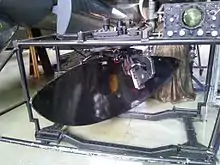 AN/APS-20 at the Museum of Science and Industry in Manchester | |
| Country of origin | United States |
|---|---|
| Manufacturer | General Electric Hazeltine |
| Introduced | 1945 |
| Type | Airborne early warning, maritime patrol, weather research |
| Frequency | S Band (APS/AN-20A), plus L and X Band (AN/APS-20E) |
| PRF | 300 Hz |
| Beamwidth | 1.5° (horizontal), 6° (vertical) |
| Pulsewidth | 2 μs |
| RPM | 3 or 6 |
| Range | 200 nmi (370 km; 230 mi) against surface ships, 65 nmi (120 km; 75 mi) (APS/AN-20B) |
| Diameter | 8 ft (2.4 m) (APS/AN-20A) |
| Power | 1 MW (APS/AN-20A) |
Background
From the early days of its development, radar had been used to detect aircraft. Early apparatus was large and required substantial power, and so was limited to fixed locations and ships. However, during World War II, increasingly smaller radar sets were developed that could be more installed in smaller platforms like aircraft.[1] At the same time, the United States Navy (USN) was aware that attacks from the aircraft of the Imperial Japanese Navy were the largest threat to their warships and protecting these ships became more dependent on aircraft carriers and their squadrons. Shipborne radar did not have sufficient range to identify attacking bombers in time to launch defensive interceptor aircraft due to the radar horizon. The solution lay in placing a radar in an aircraft.[2] Night fighter radars proved inadequate for the task. Optimised for aerial combat, they were too short ranged to fulfil the necessary long-range aerial surveillance role.[3]
Design and development
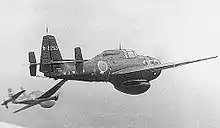
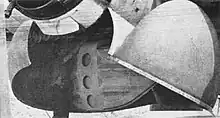
The solution to the problem of detecting objects beyond the horizon lay in developing a dedicated airborne early warning radar. On 2 February 1942, the USN commissioned the Radiation Laboratory at the Massachusetts Institute of Technology (MIT) to explore an airborne radar design dedicated to seeking aircraft under Project Cadillac, named after the Cadillac Mountain in Maine.[4] The team grew rapidly from 37, including 10 officers, in May 1943 to 138 at the end of the War. The outcome of the development was an S-Band radar designated AN/APS-20.[3] Development continued in two guises. Cadillac I, the initial platform, was to be carrier-based and the first radar was to be fitted to converted General Motors TBM-3 Avenger torpedo bombers.[6] Simultaneously, the need for a version for larger land-based aircraft was recognised. Under the guise of Cadillac II, it was decided that the Boeing B-17G Flying Fortress heavy bomber was to be fitted with the radar.[7]
The production radar was manufactured by General Electric and Hazeltine.[8] The first version, the AN/APS-20A, had, initially, an 8-foot-4-inch (2.54 m) antenna and operated on a frequency of 2850 MHz in the S band.[3] Later a slightly smaller 8 ft (2.4 m) antenna was used.[8] The scanner had two speeds, 3 and 6 revolutions per minute. The radar worked at a Pulse Repetition Frequency (PRF) of 300 Hz, a pulse length of 2 μm (7.9×10−5 in). Peak power was 1 megawatt (1,300 hp).[9] The AN/APS-20B, designed to be carried by larger aircraft, differed in size and capability. It had a peak power of 2 MW (2,700 hp) and a horizontal beam width of 1.5° and vertical of 6°. Pulse width remained 2 μs.[10] Range was extended to 65 nautical miles (120 km; 75 mi) against low flying aircraft and 200 nautical miles (370 km; 230 mi) against shipping.[11]
Later versions expanded the capability. The AN/APS-20F extended the range against aircraft to 80 nautical miles (150 km; 92 mi), while the larger AN/APS-20E could detect an aerial 1 m2 (11 sq ft) target at 115 nautical miles (213 km; 132 mi).[12] Initially deployed in 1953, the E model operated in the L band, S band and X band, with a wide selection of PRFs and pulse widths in each band. It also included automatic target indication, three choices of heading reference and stabilization, selectable azimuth and elevation beam widths, selectable output and receiver radiated gain and automatic gain control amongst other features.[13]
Service
Trials and initial use
The first aircraft equipped with the AN/APS-20 was a converted TBM-3 Avenger, designated XTBM-3W, which first flew on 5 August 1944. The radar was mounted in a radome under the forward fuselage. A series of aircraft were converted from existing TBM-3 airframes by the Naval Aircraft Modification Unit and designated TBM-3W, with initial training aboard the aircraft carrier Ranger starting in May 1945.[14] At the same time, 31 large Boeing PB-1W aircraft were converted from B-17G Flying Fortresses to become the first land-based aircraft equipped with the radar. They were especially designed to combat the increasing threat of Japanese Kamikaze attacks.[7] The crew of the Avenger consisted of, as well as the pilot, a single Radar Operator (RO). The larger size of the PB-1W allowed for two ROs, an Electronics Technician and, critically, a Combat Information Center (CIC) Officer supported by two radio operators. The latter team was able to direct aircraft to the target, adding the ability of the aircraft to control fighter aircraft and enabling operation independent of shipboard or ground-based control. This capability was later developed into the Airborne Warning and Control System (AWACS). The war ended before either aircraft became operational.[15]
Post-war, the USN quickly accelerated a program to get the radar into service. The AN/APS-20 was installed in the Douglas AD-3W Skyraider, which replaced the Avenger, and the Lockheed PO-2W Warning Star, a specialised platform developed from the Lockheed L-1049 Super Constellation airliner.[16] Both also saw service outside the USN. The latter, which could carry up to 32 servicemen for long trips, so impressed the newly formed United States Air Force (USAF) that it ordered it into service as the EC-121 Warning Star. Following a test between 24 February and 23 March 1953, the USAF used their aircraft to mount a near-continuous monitor of potential incursion by the Soviet Air Forces of American continental airspace.[17] At the same time, the Royal Navy procured fifty examples of the AD-3W as the Skyraider AEW.1. This was the first use of the radar the a non-US operator.[18] Meanwhile, in an attempt to extend endurance, in 1954 the USN ordered the installation of the radar in a blimp, the ZP2N-1W, later redesigned ZPG-2W and then, in 1962, EZ-1B.[19] The last example retired in October 1962, not only ending the use of the radar in airships but also all lighter than air operations by the service.[20]
Expanding capabilities
Alongside these developments, new uses of the radar were explored. One arena where the radar broke new ground was in weather research, particularly with the hurricane hunters that flew into tropical cyclones. The first trials of the radar took place in 1946 with a PB-1W and on 15 September 1953 the newly created weather squadron VJ2 flew the first aircraft equipped with an APS/AN-20 into a hurricane, Hurricane Dolly.[21] Equipped with the dedicated WV-3 Warning Star from 1956, the squadron frequently flew up to three times a week on tropical cyclone observation.[22] At the same time, VW-1 was providing a similar service tracking typhoons in the Pacific. Other users of the radar included the Environmental Science Services Administration (ESSA) and its successor the National Oceanic and Atmospheric Administration (NOAA).[24] Aircraft operated by these agencies were also made available to universities, and therefore the radar was also used as a tool for academic research where its attributes proved invaluable in the study of precipitation.[25] It was used in a wide range of airframes, including converted Douglas DC-6 airliners and the dedicated Lockheed WP-3A Orion which served into the 1970s.[26][27]
_APS-20E_radome_right_front_view_at_Kanoya_Naval_Air_Base_Museum_April_29%252C_2017.jpg.webp)
Meanwhile, in 1948, the UK evaluated a PB-1W equipped with AN/APS-20 against a Vickers Warwick V fitted with ASV.13 to see if the radar could also be used to identify surface ships, but the peak power was deemed too high and the pulse length too long for the application.[9] Nonetheless, the Royal Canadian Air Force (RCAF) used the radar in their maritime surveillance Canadair Argus Mk.1.[28] The USN also looked to mount the radar on its carrier-borne anti-submarine aircraft, commissioning Grumman to use it in the design which eventually became the Grumman S2F Tracker.[29] Of greater impact, however, was the improved AN/APS-20E subsequently used in the role in the Lockheed P2V Neptune. The radar first flew in the third airframe, designated P2V-2S, which was the first developed for the anti-submarine role.[30] It proved effective at identifying large surface ships up to 200 nautical miles (370 km; 230 mi) away but was ineffectual when tracking periscopes.[31] Subsequently, the airframe was adopted by a range of operators, from the Argentine Navy to the Republic of China Air Force.[32]
The AN/APS-20 was also briefly used as part of the Space Race, supporting Project Mercury, where the radar's long range enabled it to be used in tracking and other tasks.[22] It was particularly used to help find returning space capsules after splashdown. For example, the radar was installed aboard aircraft of VP-5 that were involved in the recovery of Commander Alan Shepard from Mercury-Redstone 3, Captain Gus Grissom from Mercury-Redstone 4 and Commander Wally Schirra from Mercury-Atlas 8.[33]
Replacement of the radar took many decades. The USAF trialled the more advanced AN/APS-82, which provided target height data, in 1956 but waited until after 1962 before replacing the radar with the AN/APS-95 aboard their Warning Stars.[34] In the meantime, the USN introduced the AN/APS-82 on board carriers in the airborne early warning role in 1959.[35] The AN/APS-80, which offered similar capabilities to the AN/APS-20 but added continuous 360° area search coverage, replaced the radar in the anti-submarine role from 1961.[31] The Canadians finally replaced their AN/APS-20 with AN/APS-115 in 1981.[36] The last operator of the radar was the Royal Air Force (RAF), which had previously used it between 1952 and 1957.[37] When the Royal Navy retired their last AN/APS-20, they were refurbished and fitted to retiring Avro Shackleton MR.2 maritime patrol aircraft. Re-entering service in 1972 with the RAF with the designation AEW.2, the aircraft continued to operate until July 1991 in the airborne early warning role.[38]
Variants
- AN/APS-20A
- Initial version developed for carrier-based aircraft with single 12 in (305 mm) CRT display.[9]
- AN/APS-20B
- Initial version developed for land-based aircraft with additional command and control capability.[11]
- AN/APS-20C
- Improved version to equip both large four-engine and carrier-borne single-engine aircraft.[39]
- AN/APS-20E
- Larger antenna version optimised for maritime patrol.[40]
- AN/APS-20F
- Version with smaller antenna and less range than the AN/APS-20E.[12]
Applications
Aircraft
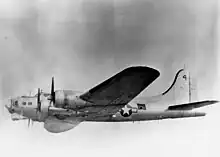
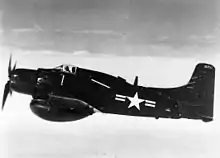
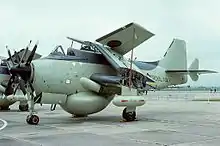
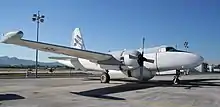
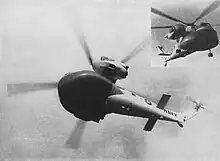
- Avro Shackleton AEW.2 – 12 converted.[18]
- Boeing B-29 Superfortress – 3 converted.[39]
- Boeing PB-1W – 32 converted.[15]
- Canadair Argus Mk.1 – 13 built.[28]
- Fairey Gannet AEW.3 – 44 built.[41]
- Douglas AD-W / EA-1 Skyraider – 367 built, including one XAD-1W prototype.[16]
- Douglas Skyraider AEW.1 – 50 built.[18]
- Douglas DC-6 – 2 converted.[26]
- Goodyear ZPG-2W – 5 built.[19]
- Goodyear ZPG-3W – 4 built.[19]
- General Motors TBM-3W Avenger – 27 converted.[14]
- Grumman Avenger Mk.3W2 – 8 delivered.[42]
- Grumman TB3F-1S / AF-2W Guardian – 156 built, including one XTB3F-1S prototype.[43]
- Lockheed PO-2W / WV-2 / EC-121 Warning Star. 232 built.[16]
- Lockheed WV-3 / WC-121 Warning Star. 8 converted.[44]
- Lockheed P2V-2S Neptune – 1 built.[30]
- Lockheed P2V-3W Neptune – 30 built.[45]
- Lockheed P2V-4 / P-2D Neptune – 51 built, including P2V-2S prototype.[40]
- Lockheed P2V-5 / P-2E Neptune – 424 built, including 52 Neptune MR.1.[37][40]
- Lockheed P2V-7 / P-2H Neptune – 287 built, including 48 assembled by Kawasaki.[40]
- Lockheed EP-3E Orion – 2 converted.[46]
- Lockheed WP-3A Orion – 4 converted.[27]
- Sikorsky HR2S-1W – 2 built.[47]
Former operators
 Argentina
Argentina
.svg.png.webp) Australia
Australia
 Brazil
Brazil
 France
France
 Japan
Japan
 Netherlands
Netherlands
 Portugal
Portugal
 Republic of China
Republic of China
 United Kingdom
United Kingdom
 United States
United States
References
Citiations
- Friedman 1985, p. 95.
- Hirst 1983, p. 58.
- Norton 2008, p. 213.
- Hirst 1983, p. 59.
- Friedman 1985, p. 146.
- Hirst 1983, p. 60.
- Streetly 1984, p. 58.
- Watts 2018, p. 8-7.
- De la Moriniere 1972, p. 210.
- Streetly 1984, p. 36.
- Friedman 1985, p. 253.
- Shannon 2014, p. 212.
- Norton 2008, p. 214.
- Hirst 1983, p. 61.
- Hirst 1983, p. 64.
- Grier 2005, p. 78.
- Hirst 1983, p. 66.
- Hirst 1983, p. 72.
- Grossnick 1987, p. 70.
- Reade 2011.
- Hunt 1963, p. 14.
- Polmar 1997, p. 537.
- Senn & Courtright 1969, p. 25.
- De la Moriniere 1972, p. 177.
- Fine 1976, p. 1.
- Chant 1980, p. 34.
- Francillon 1989, p. 554.
- Francillon 1987, p. 264.
- Shannon 2014, p. 213.
- Francillon 1989, p. 278.
- Roberts 2000, p. 46.
- Francillon 1989, p. 317.
- Francillon 1989, p. 404.
- Francillon 1987, p. 413.
- Howard 1972, p. 285.
- Tyack 2005, p. 87.
- Lloyd 1987, p. 63.
- Chant 1980, p. 62.
- Chant 1980, p. 191.
- Skaarup 2001, p. 41.
- Francillon 1989, pp. 278, 281.
- Francillon 1987, p. 320.
- Francillon 1987, p. 265.
- Polmar 1997, p. 379.
- Gunston 1977, p. 59.
- Chant 1980, p. 17.
- Chant 1980, p. 19.
- Chant 1980, p. 28.
- Chant 1980, p. 92.
- Chant 1980, p. 113.
- Chant 1980, p. 126.
- Senn & Courtright 1969, p. 24.
- Hirst 1983, p. 65.
Bibliography
- Chant, Christopher (1980). The World's Air Forces. Newton Abbot: David & Charles. ISBN 978-0-71537-690-4.
- De la Moriniere, Terry (1972). BOMEX Temporary Archive Description of Available Data (Report). Washington: NOAA. Retrieved 11 June 2020.
- Fine, Frederick (1976). VHF-UHF Aircraft Antenna (Report). Vol. 8012. Washington DC: Naval Research Laboratory.
- Francillon, René J. (1989). Grumman Aircraft Since 1929. London: Putnam. ISBN 978-0-85177-835-8.
- Francillon, René J. (1987). Lockheed Aircraft since 1913. London: Putnam. ISBN 978-0-85177-805-1.
- Friedman, Norman (1985). U.S. Naval Weapons: Every Gun, Missile, Mine, and Torpedo Used by the U.S. Navy from 1883 to the Present Day. Annapolis: Naval Institute Press. ISBN 978-0-87021-735-7.
- Grier, Paul (April 2005). "The Fall of the Warning Stars". Air Force Magazine. 88: 78–79.
- Gunston, Bill (1977). Helicopters at War. London: Chartwell Books. ISBN 978-0-70260-020-3.
- Grossnick, Roy A., ed. (1987). Kite Balloons to Airships: The Navy's Lighter-than-air Experience. Washington DC: Deputy Chief of Naval Operations (Air Warfare), Naval Air Systems Command. OCLC 606396280.
- Hirst, Mike (1983). Airborne Early Warning: Design, Development, and Operations. London: Osprey. ISBN 978-0-85045-532-8.
- Howard, Peter J. (August 1972). "The Lockheed Neptune in R.A.F. Service: Part 1". Air Pictorial. 34 (8): 284–289, 294.
- Hunt, Jack (April 1963). "They Hunt the Hurricanes". Naval Aviation News: 14–17.
- Lloyd, Alwyn T. (1987). B-29 Superfortress in Detail & Scale. Blue Ridge Summit: Tab Books. ISBN 978-0-83068-035-1.
- "Navymen Go Where the Wild Winds Blow". Naval Aviation News: 14–17. January 1955.
{{cite journal}}: CS1 maint: date and year (link) - Norton, William (2008). U.S. Experimental & Prototype Aircraft Projects. North Branch: Specialty Press. ISBN 978-1-58007-109-3.
- Polmar, Norman (1997). Naval Institute Guide to the Ships and Aircraft of the U.S. Fleet. Annapolis: Naval Institute. ISBN 978-1-55750-686-3.
- "Project Cast: Radar Learns to Fly". Naval Aviation News: 1–4. April 1946. Retrieved 17 October 2020.
{{cite journal}}: CS1 maint: date and year (link) - Reade, David (15 December 2011). "Storm Hunters: The Navy's Hurricane Reconnaissance Units". Naval Aviation News. Archived from the original on 9 July 2020. Retrieved 11 June 2020.
- Roberts, Michael (2000). Dictionary of American Naval Aviation Squadrons, Volume 2: The History of VP, VPB, VP(H) and VP(AM) Squadrons (PDF). Washington DC: Naval Historical Center, Department of the Navy. Retrieved 17 October 2020.
- Senn, Harry V.; Courtright, Charles L. (1969). Radar Hurricane Research 1 September 1968 to 31 August 1969 (PDF) (Report). Miami: Rosenstiel School of Marine and Atmospheric Sciences, University of Miami. Archived (PDF) from the original on June 11, 2020. Retrieved 11 June 2020.
- Shannon, John G. (January 2014). "A History of U.S. Navy Airborne and Shipboard Periscope Detection Radar Design and Development". U.S. Navy Journal of Underwater Acoustics. 62 (1): 203–231.
{{cite journal}}: CS1 maint: date and year (link) - Skaarup, Harold A. (2001). Canadian Warbirds of the Post-War Piston Era. San Jose: Writers Club Press. ISBN 978-0-59518-420-0.
- Streetly, Martin (1984). World Electronic Warfare Aircraft. London: Jane's. ISBN 978-0-71060-166-7.
- Tyack, Bill (2005). "Maritime Patrol in the Piston Engine Era" (PDF). Royal Air Force Historical Society Journal (33): 67–89. ISSN 1361-4231. Retrieved 11 June 2020.
- Watts, Simon (2018). Airborne Maritime Surveillance Radar: Volume 2, Post-war British ASV Radars 1946-2000. San Rafael: Morgan & Claypool. ISBN 978-1-64327-073-9.